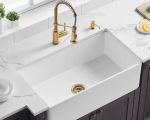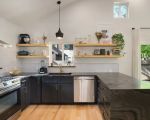How to Choose the Right Backsplash for Your Kitchen: A Complete Guide
As someone who recently remodeled my kitchen, I can confidently say that choosing the right backsplash was one of the most exciting—and challenging—parts of the process. The backsplash is one of the most visible features of a kitchen, and it has the power to completely transform the space. Whether you're renovating your entire kitchen or just looking to make a small change, the backsplash can tie the whole room together. But how do you decide which style, material, and color will work best for your kitchen? In this article, I’ll share everything I learned about choosing the perfect backsplash for your kitchen, based on my own experience and the tips I gathered along the way.
Through trial and error, I learned that there are a lot of factors to consider when choosing a backsplash. From the materials and colors to the layout and finish, each choice affects the overall look and feel of the kitchen. But don’t worry—I’m here to break it all down for you and make the decision process easier. By the end of this article, you’ll feel confident in your ability to choose a backsplash that perfectly complements your kitchen’s style, functionality, and aesthetic.
1. Consider the Style and Theme of Your Kitchen
The first thing I learned when picking a backsplash was that it needs to match the style of your kitchen. Whether your kitchen is modern, rustic, or somewhere in between, your backsplash should reflect that style. I spent a lot of time thinking about my kitchen’s overall vibe before narrowing down my backsplash choices.
For example, if you have a modern kitchen, you might want a sleek, minimalist backsplash with simple geometric patterns or a neutral color palette. For a more rustic kitchen, a backsplash with textured tiles, like subway tiles in an earthy color, might be the perfect match. If your kitchen has a farmhouse style, you might consider a classic white subway tile or even a backsplash made of reclaimed wood for added charm.
When I first started thinking about my own kitchen, I realized that I wanted something that would complement my modern, clean aesthetic. After browsing through design magazines and online inspiration boards, I decided to go with white subway tiles in a herringbone pattern, which added a bit of personality while still keeping the overall feel of the kitchen fresh and contemporary.
2. Choose the Right Material for Durability and Maintenance
One of the biggest considerations when choosing a backsplash is durability. Kitchens can get messy, so your backsplash needs to stand up to grease, food splashes, and even occasional stains. During my research, I found that different materials have varying levels of durability and ease of cleaning. The last thing I wanted was a backsplash that would be difficult to maintain or one that would show wear and tear too quickly.
Here are a few popular backsplash materials and what I learned about their durability:
2.1 Ceramic or Porcelain Tiles
Ceramic and porcelain tiles are some of the most common backsplash materials, and for good reason. They are durable, water-resistant, and relatively easy to clean. I decided to go with porcelain tiles for my backsplash because they’re tough, long-lasting, and can withstand the heat and moisture typically found in the kitchen. They also come in a variety of colors, shapes, and sizes, making it easy to find something that suits your design needs.
2.2 Glass Tiles
Glass tiles are a great choice for those who want a sleek, modern look. They reflect light beautifully and are easy to maintain, though they can be more prone to scratching. I was initially drawn to glass tiles because of their shiny finish and elegant look, but I opted out after considering how high-maintenance they might be in a busy kitchen.
2.3 Natural Stone (Marble, Granite, or Slate)
Natural stone, like marble or granite, is an elegant and luxurious choice for a backsplash. However, I found that while they are durable, they can require extra care to keep them looking pristine. They are also more susceptible to staining, especially in a kitchen environment. If you love the look of natural stone but don’t want the upkeep, you might want to consider using it sparingly, like for an accent wall, rather than covering the entire area.
2.4 Stainless Steel or Metal Tiles
Stainless steel is a great material for kitchens because it’s incredibly durable and resistant to heat and moisture. If you’re going for an industrial or modern vibe, this might be the perfect choice for your backsplash. While I was drawn to the sleek, professional look of stainless steel, I ultimately chose porcelain tiles for their easier maintenance and softer aesthetic.
3. Pick the Right Color to Complement Your Kitchen
When I was deciding on the color for my backsplash, I had to think about how it would fit into my overall kitchen design. The color of your backsplash should not only complement the color scheme of your cabinets and countertops but also the size and natural light of your kitchen. A darker color can make a kitchen feel cozy, while lighter tones can open up the space and create a more airy, fresh atmosphere.
For example, if your kitchen has dark cabinets, you might want to choose a lighter backsplash color to contrast and brighten the space. White or light gray tiles can make the kitchen feel more expansive and reflective of light. On the other hand, if your kitchen is more minimalist, a bold color or pattern might be the perfect way to add a touch of personality. I opted for a white, classic look with subtle variation in the tiles to create a clean, timeless backdrop for the rest of my kitchen design.
4. Consider the Layout and Size of Your Backsplash
Another important factor to consider when choosing a backsplash is the layout. While subway tiles are a popular choice, they come in many patterns, from the traditional straight horizontal layout to diagonal or herringbone designs. Each layout can drastically change the overall feel of your kitchen. When I was choosing my backsplash, I tried out different patterns and decided on a herringbone pattern because it added a bit of flair and elegance without being too overwhelming.
The size of the tiles is another consideration. Larger tiles, for example, can make a small kitchen feel bigger by reducing grout lines, while smaller tiles or mosaics can add texture and intricate detail. It all depends on the style you want to achieve. I went with smaller tiles because they gave the space more depth and worked well with the other elements in my kitchen.
5. Budget Considerations
As with any home improvement project, the cost of a backsplash can vary greatly depending on the material, size, and installation method. I found that porcelain tiles, while affordable, still gave me the look I wanted without breaking the bank. Natural stone, on the other hand, can be more expensive, both in terms of material and installation costs.
If you’re on a tighter budget, there are plenty of cost-effective options that still offer style and durability. Many manufacturers offer affordable ceramic tiles that mimic the look of pricier materials like marble or granite. These tiles can give you the high-end look you want without the hefty price tag. I kept my budget in mind by choosing a moderately priced tile that was durable, stylish, and still fit within my project’s financial plan.








